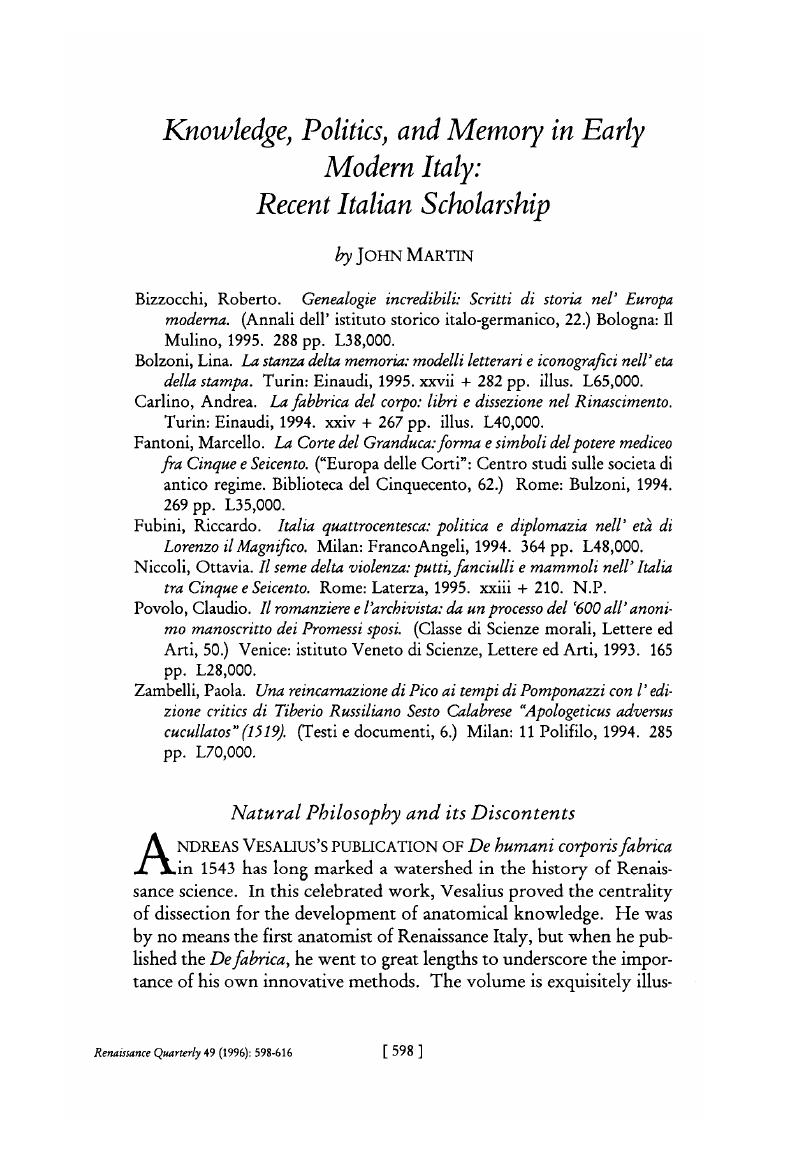No CrossRef data available.
Published online by Cambridge University Press: 20 November 2018

1 Katharine Park, “The Criminal and the Saintly Body: Autopsy and Dissection in Renaissance Italy,” Renaissance Quarterly 47 (1994): 1-33; the passage cited is from 3.
2 Curiously, another edition of this work was recently published in Italy: Tiberio Russiliano Sesto Calabrese, Apologeticus adversus cucullatos (Cosenza: Periferia, 1991) with notes and a translation by Luigi de Franco. Of the two editions, Zambelli's— which was well underway when de Franco's appeared — is the more scholarly and reliable. Zambelli's earlier works on this figure include her Une réincarnation de Jean Pic à l'époque de Pomponazzi (Wiesbaden: Steiner, 1977); “Una disputa filosofica ereticale proposta nelle università padane nel 1519,” in Paolo Rossi et al., eds., Il Rinascimento nelle corti padane: societa e cultura (Bari: De Donato, 1977); and “‘;Aristotelismo eclettico’ o polemiche clandestine? Immortalita dell'anima e vicissitudini della storia universales in Pomponazzi, Nifo e Tiberio Russiliano,” in Olaf Pluta, ed., Die Philosophie im 14. und 15. Jahrhundert: In Memoriam Konstanty Michalski (Amsterdam: B.R.Gruner, 1988), 451-93.
3 Lorenzo de’ Medici, Lettere, vols. I and II, ed. Riccardo Fubini (Florence: Istituto Nazionale di Studi sul Rinascimento, 1977).
4 On Fubini's view of the significance and limitations of Baron's work, see Fubini, “Renaissance Historian: The Career of Hans Baron,” Journal of Modern History 64 (1992): 541-74.
5 An English version of the essay, “From Social to Political Representation in Renaissance Florence” appears in Anthony Molho et al., eds., City-States in Classical Antiquity and Medieval Italy (Ann Arbor: University of Michigan Press, 1991), 223-40; there is also an English translation of another of the essays published in Italia quattrocentesca: “The Italian League and the Balance of Power at the Accession of Lorenzo de’ Medici,” Journal of Modern History 67, supp. (1995): S 166-99.
6 Peter Burke, The Fabrication of Louis XIV(New Haven: Yale University Press,1992).
7 Richard Trexler, “Ritual in Florence: Adolescence and Salvation in the Renaissance,” in Charles Trinkaus, ed., The Pursuit of Holiness in Late Medieval and Renaissance Religion (Leiden: E.J. Brill, 1974), 200-64; and Donald Weinstein, Savonarola and Florence: Prophecy and Patriotism in the Renaissance (Princeton: Princeton UniversityPress, 1970).
8 The current American historiography of this period in Italian history has also moved away from an emphasis on the Renaissance or the Renaissance problem; see Edward Muir, “The Italian Renaissance in America,” American Historical Review 100(1995): 1095-118. Significant too is the recent decision by its editors to change thename of the Journal of Medieval and Renaissance Studies to the Journal of Medieval and Early Modern Studies. My concluding remarks attempt to tie together my reading of not only the texts reviewed here but also the books reviewed in two earlier essays: see John Martin, “Recent Italian Works on the Renaissance: Perspectives on Intellectual,Political, and Social History,” Renaissance Quarterly 47 (1994): 623-38; and “Recent Italian Scholarship on the Renaissance: Aspects of Christianity in Late Medieval and Early Modern Italy,” Renaissance Quarterly48 (1995): 593-610.